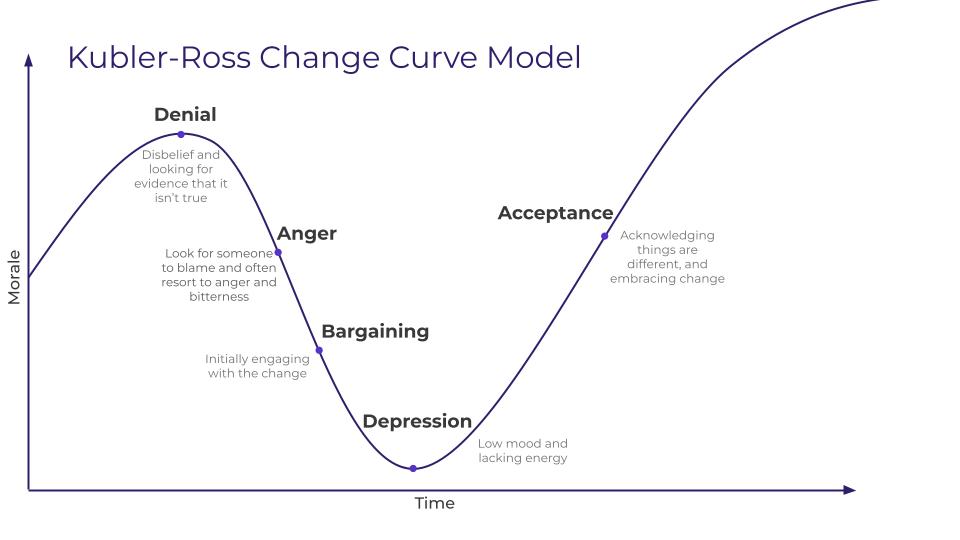From healthcare to retail, employee engagement is more than just sending a weekly newsletter—it requires a two-way conversation between employees and companies, and a desire to redefine the digital employee experience. Recently, Firstup strategic advisors Becky Graebe and Rey Bouknight sat down to discuss some of the challenges organizations are facing, and how our customers are supporting their workforce during these unprecedented times.
Authentic employee engagement has never been more important
With the pandemic, we all have experienced a season of unprecedented change, and with change often what comes is a host of negative emotions. The Kubler-Ross Change Curve® model, a worldwide accepted way to explain the change process that shows the emotions we go through during extremely traumatic experiences or other situations like work and business, can be applied here as well.

So during these difficult times of change and uncertainty, what are employees most desperate to receive from their employer? It should be no surprise that effective communication is key because it helps the employee navigate the challenging stages of the curve and arrive at a place where they feel confident operating in a new normal. How well the employer is able to communicate impacts not only how the employee feel about themselves professionally, but also about their personal lives.
That’s because we spend such a big chunk of our lives at work—over a third of our lives! Nearly half, 45 percent, of those who transitioned to remote work because of the pandemic, say they regularly work more hours during the week than they did before. Separate research from the National Bureau of Economic Research (NBER) showed that the average workday has lengthened by 48.5 minutes. So, the line between work and home keeps pushing out to the point where we’re just worn out and depleted.
It’s no wonder we’re encountering the Great Resignation and a deluge of unhappy employees leaving their jobs. In the US alone, a record 4.4 million people quit their jobs in the month of September, representing a 20-year high! Organizations are understandably scrambling to find ways to connect with their workforce to better understand and address the dissatisfaction in an attempt to retain and support their employees.
Just how prominent are these challenges in the workforce, and how can organizations resolve them? Here are seven real-world examples from some of the top organizations in the world on how they are addressing these challenges and solving for the uncertain road ahead.
1. The root cause of unhappiness
Let’s be honest—employee experience issues predated the pandemic, but they did become pronounced. Employees got more experience with work-from-home and hybrid formats, and have had more time to reflect on how they would like to work, and the lack of a good working environment has become a significant contributor to dissatisfaction in the workplace.
From our own survey, we found that almost 40% of employees want a better line of communication between executives and employees, and are wanting that communication to reach them directly where they spend their workday.
ADM: Archer Daniels Midland
ADM is a global leader in human and animal nutrition, producing the food that we’re eating and feeding our pets and livestock. Headquartered in Chicago with 800 locations worldwide, they have over 40,000 employees, 50% of which are working in plants and facilities around the world. ADM was challenged with how to engage their vast employee network in a more modern way, and be able to have a multi-way dialogue to reach and engage a broader audience.
Through the use of their employee engagement platform, ADM’s Inside News, they were able to create a single source of truth to feed all of their channels and endpoints. Additionally, they used email to direct people back into the platform for deeper content. Employees were hungry and excited for a new way of engaging and jumped in to be part of the journey
ADM is like many companies that for a long time had to rely upon floor managers or team supervisors to cascade immediate information either because the technology just didn’t exist to connect frontline workers or there were cost or knowledge barriers. But personal devices really changed all of that, and in doing so have taken some of the burdens off frontline supervisors and allowed ADM to empower individuals.
“Within a month, we went from 1,800 people to 18,000 people looking at the content on a regular basis.”
— Brett Lutz, ADM
While some employees have easy access to information, resources and benefits, others struggle to tap into those resources. At ADM, they saw immediate and vast engagement once they focused on providing convenient access to employee resources and information.
2. Feeling and being valued
Research shows that there is an increasing desire within the workforce to feel that their work is valuable to society or the organization. Yet only half of the 5,000 US workers we surveyed actually feel valued in their role. One way to help employees feel valued is to make sure they are aware of what’s happening in an organization and make connections between employees across all levels of a business.
Raising Cane’s
Known for its ONE LOVE® chicken finger meals, Raising Cane’s has over 35,000 employees across more than 500 locations. With a core 16-22-year-old workforce, their leadership and comms teams found it difficult to reach employees across locations in a timely way. They also lacked a way to collect and share insights and fun content created by employees and wanted a more social and approachable way for leaders to share news, updates and recognition.
Their 1LV Crew app is the place where employees from across the company connect with each other, submitting their thoughts and ideas about work, sharing the fun, and staying safe. The fun part of their mobile-first platform is well-suited for Raising Cane’s younger workforce and shows the value of employee input.
In this safe and creative environment, employees share everything from time-saving and quality-improving work processes to excitement over new restaurant openings and community events. Crew comments are not only allowed, they are encouraged—to the tune of more than 90,000 in the first eight months!
“It’s an opportunity for us to allow our crew to be creative, to be involved, and to share in the messaging and the community that we’re trying to create.”
— Todd Roby, Senior Director of Communications, Fry Cook and Cashier
Leaders use the platform to share in-the-moment videos and gather direct feedback on new work processes, equipment prototypes, designs for a new generation of Crew uniform T-shirts, even ideas for restaurant music playlists—with over 100 leadership videos shared during COVID. With this broad and engaging scope, 1LV Crew has become an essential part of the Raising Cane’s Crew experience.
3. The rise of mental health
The importance, and understanding, of mental health by organizations is on the rise, but identification alone is not enough—employees want action. Many of those we surveyed felt that despite recognizing their employer’s intention to support the mental health of its employees, efforts have fallen short.
Hawai’i Pacific Health
These past few years have been especially hard on healthcare workers. Over the past year, over sixty percent of healthcare workers reported experiencing some kind of burnout, which meant that the Hawai’i Pacific Health comms team had to put as much focus on wellness as they did on other communication. They found that it came down to listening, empathy, striving to understand, and then taking real action on what’s needed. All of which rely on solid communication.
As a non-profit network of hospitals, clinics, physicians and care providers covering Hawaii and the Pacific Region, Hawai’i Pacific Health has over 7,000 staff, many of which were working twelve-hour shifts on-site during the height of the COVID outbreak.
“There was just such a desperate need for information because the anxiety level was so high, that we needed a way to get messages out to people very, very quickly because there were just so many unanswered questions. This really helped us communicate with our folks quickly.”
– Raquel Hicks, Director of Organizational Effectiveness
In the beginning, they struggled to reach employees and medical staff in multiple locations with policies and protocols changing hour by hour. They knew they needed a better way for leaders to speak directly to staff in authentic and transparent ways to ease tension, bolster confidence and recognize the incredible efforts being made. Their staff also lacked easy access to wellness resources to counter the rising anxiety and burnout.
In response, the team launched a number of wellbeing initiatives, offering mindfulness and meditation opportunities and a wellbeing podcast, in which two HPH employees share stories and conversations from frontline workers across the community.
The pandemic forced every organization to be more nimble—from figuring out how to work from home while your kids are distance-learning, or finding ways to continue your social activities in a safe way. This is certainly the case for communicators as well.
Big Lots
Headquartered in Columbus, Ohio, Big Lots has over 1,400 stores in 47 states, and have always put mental health at the forefront, most notably through their $50 million gift in support of the Big Lots Behavioral Health Pavilion at Nationwide Children’s Hospital to support youth mental health and mental wellness.
Although healthcare workers deserve all the support we can give them during this time, Big Lots found that their own frontline workers were experiencing similar challenges, but not getting the same attention or care. They were struggling with how to keep their employees safe along with helping employees keep customers safe.
The key was to, “care about the whole person,” and see them for more than just the job that an employee performs, but who is waiting for them at home, and what other challenges they might be facing. Then talk openly about mental health and its impact.
“…we really tried to make sure that we cared about the whole person and making sure that we talked about mental health, taking care of your mental health.”
— Jeremy Ball, VP of Internal Comms, Philanthropy and Events
By normalizing these conversations by making sure employees see and hear this on a regular basis, from all levels of people in the organization, alongside resources to help them address those feelings, organizations can begin to make a real difference.
4. In-office versus deskless
The pandemic has increased the proportion of deskless workers and the disparity between in-office and deskless employees has become more prominent. Deskless workers are feeling more neglected in terms of career progression and life balance compared to their desk-based peers. Providing equal opportunities to both groups and facilitating effective collaboration between them is critical.
Big Lots
Along with mental health, Big Lots recognized that a huge piece of leveling the disparities between office and frontline workers came down to culture— building a community among all of their associates. They realized they have to make sure that they harness the power of communication to drive business goals and communicate strategy.
Big Lots launched The Beat platform which gave employees the ability to recognize and express value in a peer-to-peer fashion. It also gave them the ability to share “up” when a team or location does something to be proud of. This created community and two-way communication with everyone, no matter where they were located.
By listening to and amplifying the voices of those closest to the customer and the processes designed to serve them, companies get access to an important perspective. People at the loading dock have a very different view of the company than those that sit in their home or corporate offices do, and when we listen to both sides, it really helps level the playing field.
5. Finding balance
As we know, achieving a life balance is often elusive, and is a prominent factor when it comes to feelings of unhappiness at work. Our survey showed a strong belief among employees that there is a lack of respect for the work they do and how long it takes, and a need for more reassurance and support from management, with almost 30% of employees wanting their employers to have a greater awareness of what a manageable workload is.
TD SYNNEX
The comms and IT teams of TD SYNNEX (previously known as Tech Data) are taking a different approach—an employee-centric approach—to communications to help tackle the lack of understanding, and drive better engagement from their workforce.
With 22,000 of the IT industry’s “best and brightest” employees on their payroll, they found cross-functional collaboration between comms, IT and HR a challenge. Everyone wanted to create a more equitable, productive digital employee experience, but each had its own approach to getting there.
They had an ‘aha’ moment that really sparked the change for their teams and their leadership.
The teams moved away from a company-centric approach to a more colleague-centric approach, during a time when leadership was adopting a more servant-leadership mentality. Like the analogy of a stock room versus the front-of-house retail experience, they optimized the user experience to be more consumable and fresh by putting the employee at the center.
“Putting the employee at the center was the game changer for us […] That helped explain things [to] everybody at the company, to convince them that this is a valid project, [for] end-users who are getting bombarded with hundreds of emails every day.”
— Adam Quinn, Engagement Lead
As people have to work around new obstacles and hurdles, the need to reduce friction and inconvenience really moved to the forefront. This whole approach toward serving each other to provide as much space for balance as possible, rather than simply a top-down communications focus, was a reset for a lot of organizations, TD SYNNEX included.
6. Retention versus recruitment
What motivates employees is a crucial point for employers and workforces to understand, not only to retain existing talent but also attract new talent into the business and uphold the company’s reputation. In our survey, workers highlighted feeling important to the company and feeling a part of a team as the most important to their retention.
Lehigh Valley Health Network
The Lehigh Valley Health Network (LVNH) network spans nine hospitals (and counting), numerous health centers, physician practices, rehabilitation locations, ExpressCARE sites, and outpatient care locations in eastern Pennsylvania. Each of their over 19,000 colleagues contributes to their mission to heal, comfort, and care for the people of their communities.
Employee turnover in healthcare is costly, and a lack of communication impacts employee satisfaction. LVHN needed to strengthen the relationship between managers and employees, as well as nurses and physicians. To counter this, their comms team used their LVNHProud platform to build a community beyond just the central hospitals, and foster connections even during a time when their employees couldn’t all come together.
The beauty of the LVNHProud platform has been how employees have rallied together to recognize and encourage each other and build a community that would have been limited to just the hospitals.
With morale being such a leading indicator of employee retention, celebrations help strengthen morale and can be a really powerful reflection of the collective spirit and true employee experience to employees and the community alike. It also supports the idea that when people have an opportunity to be part of something bigger than themselves they will be more loyal to an organization.
Wawa
Iconic Wawa is an East Coast chain of 24-hour convenience stores with 33,000 employees who are shift-work employees with limited connection to the corporate office. With more than 900 locations across six states, they still operate with a mom-and-pop mindset, putting the customers first and delivering an employee experience so exceptional that many of the company’s associates stay on for decades. It’s also why they’ve been dubbed the “Cheers” of convenience stores since customers drop by often more than once a day because their associates know them by name, know their order preferences, and have real relationships with them.
So it makes sense that leaders and decision-makers want to know what these dedicated associates think when it comes to making changes or improvements in their stores, packaging, product offerings. Listen to what they’re doing to give voice to those frontline ideas.
The solution was right in the pockets of employees—their mobile devices. They branded their platform “The Honker,” which reflects the company’s goose theme, and gives Wawa the ability to effectively engage their dispersed workforce.
The company delivers information to employees such as new sales programs and essential safety announcements. It also uses surveys to get the pulse of employees on various topics, and the CEO regularly records short, breezy videos to connect with employees. The app also allows store employees to notify the corporate home office of any issues—allowing Wawa to solve problems quickly, and solve issues for customers and colleagues in a timely manner.
7. Orchestrating a solution
Connecting the workforce—that’s what it’s all about, coming together to accomplish something important and impactful. Through improved communication, valuing employee contributions, supporting mental health, recognizing worker needs regardless of location, respecting the work/life balance and putting people first, organizations can reap the benefits of a happy workforce.
Dow
The science and technology company Dow has over 50,000 employees, sixty percent of which are in manufacturing. They were challenged with communication tools that were strictly push and not personalized. With too many channels and employee communication methods, it was difficult for employees to get the big picture.
Now, with its branded mobile app, Dow Connect, the company reaches and engages with 100% of its workforce!
“Dow Connect brings the story to employees in one singular place. It’s easy to use, it’s intuitive, and it’s easy for us to have the power and control to give access to those other storytellers at the company.”
— Jenn Holzinger, Lead of Global Employee and HR Communications
By putting communications in the hands of their people, organizations like Dow are connecting the employee experience across their workforce and in ways that resonate with their workforce.
Putting people first
The examples Becky and Rey shared prove that happier workforces are attainable, even during the hardest of times. These organizations are combating the challenges head-on, by putting their employees first. You can watch the entire webinar on-demand, or contact us to learn more about the Firstup platform.











